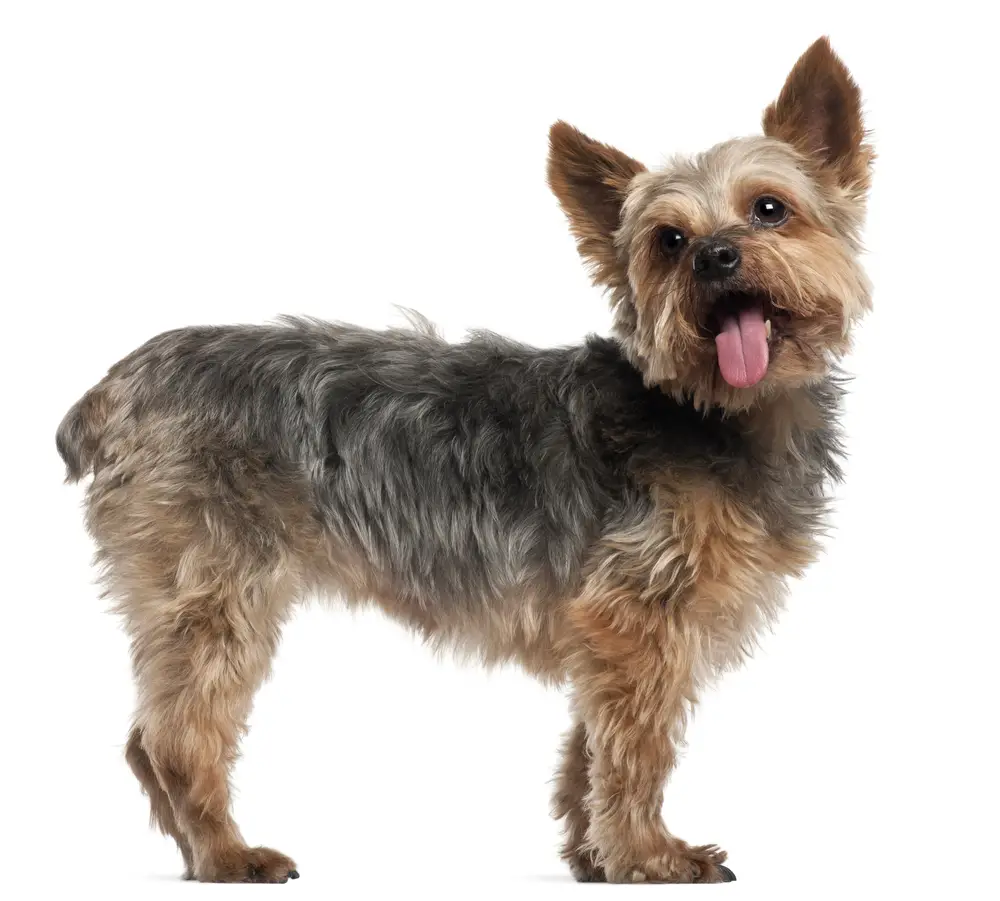Yorkie Health Issues
Yorkie Health Issues

Boboy – Courtesy of Maria Diosdado
Surprisingly intelligent and energetic for such a tiny pup, Yorkshire Terriers have unique needs that need to be considered. Yorkshire Terriers are prone to several health issues and genetic diseases you will need to watch for as your pup grows up.
Sometimes genetic diseases in Yorkies skip a generation or show up unexpectedly. A large share of Yorkies have at least one common problem like a collapsed trachea, hypoglycemia, or luxating patella. The following are the most common diseases and health concerns you should understand when you have a Yorkie.
Hypoglycemia
Hypoglycemia affects pups that are newly born to the age of 4 months. The sooner the diagnosis, the sooner one can save a pup from falling victim to the disease.
Hypoglycemia is also observed in adult Yorkies. If the dogs are suffering from Addison’s disease or are pregnant, there are chances that the canine may suffer from hypoglycemia. The presence of sepsis and liver disease can also give rise to hypoglycemia.
What is hypoglycemia?
Hypoglycemia refers to a rapid drop in blood sugar levels with affects your pup’s energy levels, motor skills, and brain function. Hypoglycemia can be caused by many factors which includes stress, small size, and a lack of proper nutrients. This is one of the most common diseases to affect Yorkies so it’s a good idea to watch your pup for symptoms.
What are the symptoms?
A Yorkie that is experiencing a drop in the blood sugar levels may display signs of fatigue and inactiveness. Because it affects brain function as well, your Yorkie may seem confused and lost. There can be a drop in body temperature as well. Your Yorkie may even display sleepiness, fainting, and tremors. A Yorkie may or may not display all the symptoms at once.
How is hypoglycemia diagnosed?

Dudley – Courtesy of Di Fleming
To diagnose hypoglycemia, your vet will order blood tests and urine analysis. Your vet will measure your pup’s blood glucose levels and evaluate their liver, kidney, and pancreatic function. A complete blood count can rule out blood-related health conditions. Urine tests may be used to screen for urinary tract infection. Your vet may order other tests like an ultrasound to rule out tumors or a cortisol test to check for Addison’s disease.
How is hypoglycemia treated?
If your Yorkie passes out or displays unusual behavior or other signs of hypoglycemia, you can rub honey or corn syrup on his gums to provide sugar. This is an effective form of emergency treatment for a hypoglycemic episode but you still need to take your pup to the vet right away. The underlying condition needs to be treated or managed through proper diet and weight management.
Your vet may recommend a high-protein diet and supplements of corn syrup or honey as needed.
Legg-Perthes Disease

Gizmo – Courtesy of Diana Zamarron
When there is insufficient blood supply to the dog’s hips, the femur will weaken. This eventually causes the cartilage around the femur to crack. Legg-Perthes is a painful condition that causes disintegration of the hip joint. Legg-Perthes typically affects Yorkies between the ages of 4 months old to 6 months old.
What are the symptoms?
A pup with Legg-Perthes will have a limp and gradual onset lameness that occurs over a period of a couple of months. Your pup may carry the affected leg, experience wasting of the thigh muscle, and experience pain when walking.
How is Legg-Perthes diagnosed?
An x-ray will usually confirm the disease by detecting changes in the hip and joint. An x-ray early in the disease may not show Legg-Perthes but it will become apparent within weeks.
How is Legg-Perthes treated?
Surgery is recommended to treat Legg-Perthes. Surgical intervention usually involves removing the head and the neck of the hip bone or femoral bone. The ligaments will then reform. Because Yorkshire Terriers are so small, they typically gain full use of their limbs easily after surgery. Recovery can take several months or to a full year.
Retinal Dysplasia
 Retinal dysplasia is an irregularity of the retina of the eye that causes blurry vision or even blindness. Retinal dysplasia is common in Yorkies as well as Beagles, Rottweilers, and Dobermans.
Retinal dysplasia is an irregularity of the retina of the eye that causes blurry vision or even blindness. Retinal dysplasia is common in Yorkies as well as Beagles, Rottweilers, and Dobermans.
What are the symptoms of Retinal Dysplasia?
Retinal dysplasia affects vision. If you notice your Yorkie bumping into stuff or having trouble with normal activities, they may have a vision problem.
In minor cases, the dog will only suffer from retinal folds. This means that there will only be some blind spots and your pup will be able to adjust in no time. In serious cases, the vision may be heavily impaired and will hinder normal activities. Your pup may bump into objects or stumble around. Visual impairment will also cause frustration and confusion.
What causes Retinal Dysplasia?
Retinal dysplasia is usually a genetic disorder but sometimes it can be caused due to an injury to the retina. Studies have also found that herpes can cause visual impairment. Being exposed to parvovirus or toxins can also result in retinal dysplasia.
How is Retinal Dysplasia diagnosed?
A simple eye exam by a certified ophthalmologist will help confirm this disorder. Make sure your Yorkie gets regular eye exams. There are also eye tests created by the Canine Eye Registry Foundation which involves testing by a certified eye specialist.
How is Retinal Dysplasia treated?
Sadly, there are no treatment available but most dogs adjust to the vision loss as they mature. With puppies that have a milder form of Retinal Dysplasia, the condition may be corrected on its own as they grow older.
However, dogs that lose their visions can be taught to live with the impairment with a little help. Take the same route while going for walks. Provide a sense of normality and consistency by placing food, water, beds, and toys in the same location always. If there are changes to be made, changes must be introduced very slowly. It’s also important not to move the furniture too often.
Luxating Patella

Gracelynn – Courtesy of Ashley Foy
The patella is the kneecap and in the case of a luxating patella, the kneecap slips in and out. This happens when the muscles and the tendons that hold the kneecap in place are too weak. In serious cases, the kneecap will stay out of place. This will cause severe pain and may lead to serious complications like loss of limb function. In Yorkies, this is usually an inherited condition. It’s believed up to 26% of Yorkies are affected.
What are the symptoms?
If your Yorkie shows signs of pain in the limb or starts limping, check for signs of a dislocated kneecap. When the kneecap slips, it causes acute pain and your Yorkie will probably yell out. If the kneecap has slipped out, your pup will also show a disinterest in bending the hind leg for obvious reasons.
How is Luxating Patella diagnosed?
The only way to get this diagnosed is to get an X-Ray and an ultrasound from the vet.
How is Luxating Patella treated?
Luxating patella can be treated with a variety of surgical and non-surgical options. There are three primary types of surgeries to fix the problem by repositioning the patella bone or stabilizing it with screws and pins. As long as the condition isn’t advanced, your vet may recommend non-surgical treatments:
- Bed rest with anti-inflammatory drugs.
- Proper nutrition and exercise to build stronger muscles.
- A canine knee brace. This is a good alternative to surgery by stabilizing the joint.
- Massaging the joint can help ease the patella into the correct position, reduce pain, and improve mobility. Your vet can show you how to safely manipulate your pup’s patella.
Collapsed Trachea
Collapsed trachea is a common health issue in toy breeds such as the Yorkshire Terrier. It also has a genetic component. This painful condition happens when the trachea becomes narrow due to the softening of the cartilage that holds the windpipe. The trachea can also collapse when the Yorkie is wearing a collar that gets tugged too hard which may cause injury to the trachea.
The best way to prevent a collapsed trachea in your Yorkie is avoiding the use of collars completely. Use a soft vest harness like no-pull Pupteck harness to avoid injury to your pup’s fragile trachea on walks.
What are the symptoms?
Your Yorkie will probably develop an unusual honking cough. They will have difficulty breathing, especially after walking or physical activity. You may even notice their gums turning a bluish color and they may faint.
How is Collapsed Trachea diagnosed?
Your Yorkie probably has a collapsed trachea if they develop a very distinctive honking cough, difficulty breathing, and bluish gums. A diagnosis by a vet can usually be made with a radiograph but sometimes fluoroscopy is necessary.
How is Collapsed Trachea treated?
In most cases, a collapsed trachea is treated with corticosteroids, bronchodilators, and cough suppressants. If your Yorkie is overweight, weight loss is important to reduce respiratory difficulty. In severe cases, surgery may be necessary with a success rate of 75% to 85%. Surgery works best for younger dogs.
Portosystemic Shunt (Liver Shunt)

Luna and Coco – Courtesy of Ina Grima
Portosystemic Shunt is a genetic disorder of the portal vein which is responsible for bringing the blood to the liver to be filtered. When a dog has this condition, the blood remains unfiltered as the portal vein is unable to take the blood to the liver. Unfiltered blood then runs through the body. It affects the brain, heart, lungs and other organs. This condition can be acquired or genetic. In Yorkies, it’s often a congenital genetic problem.
What are the symptoms of Yorkie Liver Shunt?
The symptoms range from behavioral changes to loss of appetite. Diarrhea and vomiting are also common. Your Yorkie will show disinterest in learning and signs of stunted growth. Signs of the disorder are most noticeable after meals. Your Yorkie will likely have episodic neurological problems like swaying, head pressing, seizures, and blindness, especially as the condition worsens.
How is Portosystemic Shunt diagnosed?
A blood test to check for high serum bile acids or blood ammonia levels will confirm the diagnosis.
What is the treatment?
Surgery is the recommended course of action once your pup is medically stable. Dogs with PSS are at risk under anesthesia so the condition must be brought under control first. The surgery may involve narrowing or tying off the abnormal shunt vessel. If surgery is not an option, the best way to manage the condition is through antibiotics and careful diet control to reduce excess ammonia production.
Tips to Keep Your Yorkie Happy and Healthy
- Make sure that your Yorkie receives quality food. Choose a dry kibble formulated for small breeds like Nutro Wholesome Essentials. Don’t give your Yorkie wet food very often as kibble helps keep their teeth and gums healthy. A balanced diet and regular, small meals are important for growth and development and to reduce the risk of illness and obesity. Your pup also needs regular meals and snacks in between as small breeds like Yorkies may vomit if they don’t eat regularly enough.
- Make sure that the Yorkie never skips its vaccinations and medication for flea and worms. Frontline Plus is a good choice because it’s affordable and effective to guard against flea- and tick-borne disease.
- Yorkies are susceptible to health problems from stress. Avoid sudden changes with food, routine, or surroundings.
- Don’t skip regular grooming. This can lead to painful tangles and matted hair. It can also cause hygiene issues as feces may get stuck to your Yorkie’s hair. Brush your Yorkie daily with a pin brush for a long hair coat or a soft brush for a short coat. Doggy grooming wipes are lifesavers for keeping your Yorkie clean and hygienic between baths.

